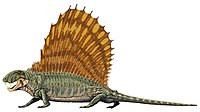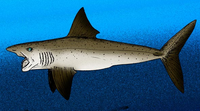Cisuralian
| Cisuralian | |||||||||||||
|---|---|---|---|---|---|---|---|---|---|---|---|---|---|
 A map of Earth 285 million years ago during the Cisuralian Epoch, Artinskian Age | |||||||||||||
| Chronology | |||||||||||||
| |||||||||||||
| Etymology | |||||||||||||
| Name formality | Formal | ||||||||||||
| Synonym(s) | Early/Lower Permian | ||||||||||||
| Usage information | |||||||||||||
| Celestial body | Earth | ||||||||||||
| Regional usage | Global (ICS) | ||||||||||||
| Time scale(s) used | ICS Time Scale | ||||||||||||
| Definition | |||||||||||||
| Chronological unit | Epoch | ||||||||||||
| Stratigraphic unit | Series | ||||||||||||
| Time span formality | Formal | ||||||||||||
| Lower boundary definition | FAD of the conodont Streptognathodus isolatus within the morphotype Streptognathodus wabaunsensis chronocline | ||||||||||||
| Lower boundary GSSP | Aidaralash, Ural Mountains, Kazakhstan 50°14′45″N 57°53′29″E / 50.2458°N 57.8914°E | ||||||||||||
| Lower GSSP ratified | 1996[2] | ||||||||||||
| Upper boundary definition | FAD of the Conodont Jinogondolella nanginkensis | ||||||||||||
| Upper boundary GSSP | Stratotype Canyon, Guadalupe Mountains, Texas, United States 31°52′36″N 104°52′36″W / 31.8767°N 104.8768°W | ||||||||||||
| Upper GSSP ratified | 2001[3] | ||||||||||||
The Cisuralian is the first series/epoch of the Permian. The Cisuralian was preceded by the Pennsylvanian and followed by the Guadalupian. The Cisuralian Epoch is named after the western slopes of the Ural Mountains in Russia and Kazakhstan and dates between 298.9 ± 0.15 – 272.3 ± 0.5 Ma.[4]
In the regional stratigraphy of southwestern North America, the Cisuralian encompasses two series: the Wolfcampian (Asselian to mid-Artinskian) and Leonardian (mid-Artinskian to Kungurian).[5][6][7]
The series saw the appearance of beetles and flies and was a relatively stable warming period of about 21 million years.
Name and background
[edit]The Cisuralian is the first series or epoch of the Permian.[8] The Cisuralian was preceded by the last Pennsylvanian epoch (Gzhelian) and is followed by the Permian Guadalupian Epoch.
The name "Cisuralian" was proposed in 1982,[9] and approved by the International Subcommission on Permian Stratigraphy in 1996.[10] The Cisuralian Epoch is named after the western slopes of the Ural Mountains in Russia and Kazakhstan.[11][12][13]
Limestones on the edge of Russian Platform and make up the Ishimbay oil fields. These oil fields were vital to the Soviet Union during WW2 when the Germans controlled the oil fields to the west.[11]
The International Chronostratigraphic Chart (v2018/07)[8] provides a numerical age of 298.9 ± 0.15 – 272.3 ± 0.5 Ma.[14]
The base of the Cisuralian series and the Permian system is defined as the place in the stratigraphic record where fossils of the conodont Streptognathodus isolatus first appear. The global reference profile for the base (the GSSP or golden spike) is located in the valley of the Aidaralash River, near Aqtöbe in the Ural Mountains of Kazakhstan.[15]
Geography
[edit]
Gondwana collided with Laurussia and created the Alleghenian orogeny in present-day North America.[11] In northwestern Europe, the Hercynian orogeny continued.[11] This created the large supercontinent, Pangea, by the middle of the early Permian, which was to have an impact on the climate.[11]
Climate
[edit]At the start of the Permian, the Late Palaeozoic Ice Age, which began in the Carboniferous, was at its peak. Glaciers receded over the course of the late Cisuralian as the Earth's climate gradually warmed,[16] particularly during the Artinskian Warming Event,[17] drying the continent's interiors.[18][19][20] The pan-tropical belt of Pangaea experienced particularly significant aridification during this epoch.[21][22][23]
Biodiversity
[edit]The swampy fringes were mostly ferns, seed ferns, and lycophytes. The series saw the appearance of beetles and flies.[11]
The coal swamps from the Carboniferous declined[24] but the herbivores, Diadectes and Edaphosaurus persisted until the end of this series, approximately.[25][26][27][12] The dry interior had small insectivores. Caseids and prototherapsid Tetraceratops made their appearance.[12] The marine life was probably more diverse than modern times as the climate warmed.[11] Unusual sharks such as Helicoprion continued in this series.
Early Permian terrestrial faunas were dominated by pelycosaurs (a paraphyletic group of early synapsids), diadectids, and temnospondyls,[28][29] The pelycosaurs appeared during the Late Carboniferous, and reached their apex in the Cisuralian remaining the dominant land animals for some 40 million years.[12][30] A few continued into the Capitanian. They were succeeded by the therapsids.[12]
-
Dimetrodon, a pelycosaur, was at the top of the food chain in the Cisuralian
-
Helicoprion bessonovi with characteristic 'tooth-whorl' at front of jaw
Subdivisions
[edit]Global
[edit]- Asselian stage (298.9 ± 0.15 – 294.6 ± 0.8 Ma)
- Sakmarian stage (294.6 ± 0.8 – 290.1 ± 0.7 Ma)
- Artinskian stage (290.1 ± 0.7 – 283.5 ± 0.7 Ma)
- Kungurian stage (283.5 ± 0.7 – 272.3 ± 0.5 Ma)
Regional
[edit]- New Zealand
- Telfordian (289 – 278 Ma)
- Mangapirian (278 – 270.6 Ma)
References
[edit]- ^ "International Chronostratigraphic Chart" (PDF). International Commission on Stratigraphy. September 2023. Retrieved November 10, 2024.
- ^ Davydov, Vladimir; Glenister, Brian; Spinosa, Claude; Ritter, Scott; Chernykh, V.; Wardlaw, B.; Snyder, W. (March 1998). "Proposal of Aidaralash as Global Stratotype Section and Point (GSSP) for base of the Permian System" (PDF). Episodes. 21: 11–18. doi:10.18814/epiiugs/1998/v21i1/003. Retrieved 7 December 2020.
- ^ "GSSP for Roadian Stage". International Commission on Stratigraphy. Retrieved 13 December 2020.
- ^ Gradstein, Felix M.; Ogg, James G.; Smith, Alan G. (2004). A Geologic Time Scale 2004. Cambridge University Press. ISBN 9780521786737.
- ^ Ross, C. A.; Ross, June R. P. (1995). "Permian Sequence Stratigraphy". The Permian of Northern Pangea. pp. 98–123. doi:10.1007/978-3-642-78593-1_7. ISBN 978-3-642-78595-5.
- ^ "Permian: Stratigraphy". UC Museum of Paleontology. University of California Berkeley. Retrieved 17 June 2021.
- ^ Henderson, C.M.; Shen, S.Z.; Gradstein, F.M.; Agterberg, F.P. (2020), "The Permian Period", Geologic Time Scale 2020, Elsevier, pp. 875–902, doi:10.1016/b978-0-12-824360-2.00024-3, ISBN 978-0-12-824360-2, retrieved 2023-09-12
- ^ a b International Commission on Stratigraphy. "Chart". Retrieved 10 July 2018.
- ^ Gradstein, Felix M.; Ogg, James G.; Smith, Alan G. (2004). A geologic time scale 2004. Cambridge University Press. p. 250. ISBN 978-0-521-78673-7.
- ^ Ganelin, V.G.; Goman'kov, A.V.; Grunt, T.A.; Durante, M.V. (January 1997). "On the revised stratigraphic scale for the Permian System adopted at the Second Guadalupian Symposium, alpine, Texas, USA, April 1996". Stratigraphy and Geological Correlation. 5 (2): 126–130.
- ^ a b c d e f g Ross, June R.P.; Ross, Charles A. (16 October 2018). "Permian Period". Encyclopædia Britannica. Retrieved 18 April 2019.
- ^ a b c d e Kazlev, M. Alan (4 May 2002). "The Cisuralian Epoch". palaeos.com. Retrieved 18 April 2019.
- ^ Allaby, Michael (2015). A Dictionary of Geology and Earth Sciences (4th ed.). Oxford University Press. doi:10.1093/acref/9780199653065.001.0001. ISBN 9780199653065.
- ^ International Commission on Stratigraphy. "GSSPs". Retrieved 10 July 2018.
- ^ Davydov, V.I.; Glenister, B.F.; Spinosa, C.; Ritter, S.M.; Chernykh, V.V.; Wardlaw, B.R. and Snyder, W.S.; 1998: Proposal of Aidaralash as Global Stratotype Section and Point (GSSP) for base of the Permian System, Episodes 21(1): pp 11–18.
- ^ Scotese, Christopher R.; Song, Haijun; Mills, Benjamin J. W.; van der Meer, Douwe G. (April 2021). "Phanerozoic paleotemperatures: The earth's changing climate during the last 540 million years". Earth-Science Reviews. 215: 103503. Bibcode:2021ESRv..21503503S. doi:10.1016/j.earscirev.2021.103503. ISSN 0012-8252. S2CID 233579194. Archived from the original on 8 January 2021. Retrieved 18 March 2023.
- ^ Marchetti, Lorenzo; Forte, Giuseppa; Kustatscher, Evelyn; DiMichele, William A.; Lucas, Spencer G.; Roghi, Guido; Juncal, Manuel A.; Hartkopf-Fröder, Christoph; Krainer, Karl; Morelli, Corrado; Ronchi, Ausonio (March 2022). "The Artinskian Warming Event: an Euramerican change in climate and the terrestrial biota during the early Permian". Earth-Science Reviews. 226: 103922. Bibcode:2022ESRv..22603922M. doi:10.1016/j.earscirev.2022.103922. S2CID 245892961. Retrieved 30 October 2022.
- ^ Michel, Lauren A.; Tabor, Neil J.; Montañez, Isabel P.; Schmitz, Mark D.; Davydov, Vladimir (15 July 2015). "Chronostratigraphy and Paleoclimatology of the Lodève Basin, France: Evidence for a pan-tropical aridification event across the Carboniferous–Permian boundary". Palaeogeography, Palaeoclimatology, Palaeoecology. 430: 118–131. Bibcode:2015PPP...430..118M. doi:10.1016/j.palaeo.2015.03.020.
- ^ Palaeos: Life Through Deep Time > The Permian Period Archived 2013-06-29 at the Wayback Machine Accessed 1 April 2013.
- ^ Grossman, Ethan L.; Yancey, Thomas E.; Jones, Thomas E.; Bruckschen, Peter; Chuvashov, Boris; Mazzullo, S. J.; Mii, Horng-sheng (24 October 2008). "Glaciation, aridification, and carbon sequestration in the Permo-Carboniferous: The isotopic record from low latitudes". Palaeogeography, Palaeoclimatology, Palaeoecology. 286 (3–4): 222–233. Bibcode:2008PPP...268..222G. doi:10.1016/j.palaeo.2008.03.053. Retrieved 30 October 2022.
- ^ Forte, Giuseppa; Kustatscher, Evelyn; Roghi, Guido; Preto, Nereo (15 April 2018). "The Permian (Kungurian, Cisuralian) palaeoenvironment and palaeoclimate of the Tregiovo Basin, Italy: Palaeobotanical, palynological and geochemical investigations". Palaeogeography, Palaeoclimatology, Palaeoecology. 495: 186–204. Bibcode:2018PPP...495..186F. doi:10.1016/j.palaeo.2018.01.012. Retrieved 22 December 2022.
- ^ Mujal, Eudald; Fortuny, Josep; Marmi, Josep; Dinarès-Turell, Jaume; Bolet, Arnau; Oms, Oriol (January 2018). "Aridification across the Carboniferous–Permian transition in central equatorial Pangea: The Catalan Pyrenean succession (NE Iberian Peninsula)". Sedimentary Geology. 363: 48–68. Bibcode:2018SedG..363...48M. doi:10.1016/j.sedgeo.2017.11.005. S2CID 133713470. Retrieved 22 December 2022.
- ^ Matamales-Andreu, Rafal; Mujal, Eudald; Dinarès-Turell, Jaume; Kustatcher, Evelyn; Roghi, Guido; Oms, Oriol; Galobart, Àngel; Fortuny, Josep (May 2022). "Early–middle Permian ecosystems of equatorial Pangaea: Integrated multi-stratigraphic and palaeontological review of the Permian of Mallorca (Balearic Islands, western Mediterranean)". Earth-Science Reviews. 228: 103948. Bibcode:2022ESRv..22803948M. doi:10.1016/j.earscirev.2022.103948. S2CID 246438404. Retrieved 3 January 2023.
- ^ Sahney, Sarda; Benton, Michael J.; Falcon-Lang, Howard J. (December 2010). "Rainforest collapse triggered Carboniferous tetrapod diversification in Euramerica". Geology. 38 (12): 1079–1082. Bibcode:2010Geo....38.1079S. doi:10.1130/g31182.1. ISSN 1943-2682.
- ^ Brocklehurst, Neil; Day, Michael O.; Rubidge, Bruce S.; Fröbisch, Jörg (12 April 2017). "Olson's Extinction and the latitudinal biodiversity gradient of tetrapods in the Permian". Proceedings of the Royal Society B: Biological Sciences. 284 (1852): 20170231. doi:10.1098/rspb.2017.0231. ISSN 0962-8452. PMC 5394676. PMID 28381616.
- ^ Didier, Gilles; Laurin, Michel (June 2024). "Testing extinction events and temporal shifts in diversification and fossilization rates through the skyline Fossilized Birth-Death (FBD) model: The example of some mid-Permian synapsid extinctions". Cladistics. 40 (3): 282–306. doi:10.1111/cla.12577. ISSN 0748-3007.
- ^ Didier, Gilles; Laurin, Michel (9 December 2021). "Distributions of extinction times from fossil ages and tree topologies: the example of mid-Permian synapsid extinctions". PeerJ. 9: e12577. doi:10.7717/peerj.12577. ISSN 2167-8359. PMC 8667717. PMID 34966586.
- ^ Huttenlocker, A. K., and E. Rega. 2012. The Paleobiology and Bone Microstructure of Pelycosaurian-grade Synapsids. Pp. 90–119 in A. Chinsamy (ed.) Forerunners of Mammals: Radiation, Histology, Biology. Indiana University Press.
- ^ "NAPC Abstracts, Sto – Tw". berkeley.edu.
- ^ Brocklehurst, Neil; Kammerer, Christian F.; Fröbisch, Jörg (23 June 2013). "The early evolution of synapsids, and the influence of sampling on their fossil record". Paleobiology. 39 (3): 470–490. Bibcode:2013Pbio...39..470B. doi:10.1666/12049. S2CID 83738138. Retrieved 2 April 2023.


